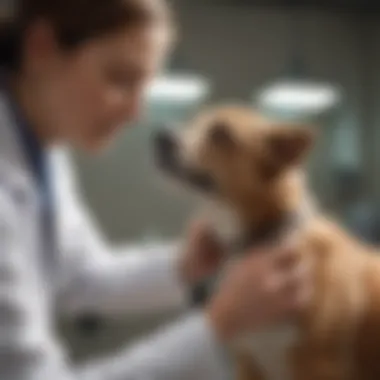Top Strategies for Combatting Fleas on Dogs and Safeguarding Their Health


Animal Species Profile
Dogs are remarkable creatures with a long history of companionship with humans. They exhibit a wide range of physical characteristics and appearances, varying in size, coat texture, and color patterns. From the majestic Great Dane to the tiny Chihuahua, the diversity in breeds is vast. Dogs have adapted to various habitats and distributions worldwide, making them one of the most versatile species. Their behavior and social interactions reflect their pack mentality, with hierarchy, communication, and cooperation playing vital roles.
Pet Care & Tips
When considering a dog as a pet, it's essential to choose a breed that aligns with your lifestyle. Factors such as size, activity level, and grooming requirements should be carefully considered to ensure a harmonious match. Basic care requirements include providing a balanced diet, regular exercise, grooming sessions, and veterinary check-ups. Maintaining your dog's health and wellness is paramount in ensuring longevity. Training techniques, including positive reinforcement and consistency, are key aspects of fostering good behavior and behavioral enrichment for your furry friend.
Understanding Fleas and Their Impact on Dogs
Understanding fleas and their impact on dogs is crucial in maintaining your pet's health and well-being. Fleas are not just pesky insects; they can pose serious risks to your dog's health, causing discomfort, allergic reactions, and even transmitting diseases. By comprehensively understanding fleas and their impact, you can effectively combat infestations and protect your beloved canine companion.
Overview of Fleas
Fleas, tiny parasitic insects, have a complex life cycle that consists of four stages: egg, larva, pupa, and adult. This cyclical process is integral to understanding how infestations develop and persist. The life cycle of fleas plays a significant role in the continual presence of these pests on dogs and in their environments. It is a constant battle for pet owners to disrupt this life cycle to eradicate fleas entirely.
Impact of Fleas on Dogs
Fleas can have devastating effects on dogs, both physically and psychologically. The constant itching and discomfort caused by flea bites can lead to skin infections, hair loss, and behavioral changes in dogs. Additionally, fleas are vectors for various diseases like tapeworm infestations and Bartonella, posing a significant health risk to both pets and humans. Understanding the impact of fleas on dogs underscores the critical need for proactive prevention and immediate treatment to safeguard your dog's health and well-being.
Identifying Fleas on Your Dog


When it comes to identifying fleas on your dog, being vigilant is key. Common signs of a flea infestation include excessive scratching, red and irritated skin, presence of flea dirt (black specks resembling pepper) on the fur, and visible live fleas on the pet. These indicators necessitate swift action to prevent the infestation from worsening and affecting your dog's health negatively.
Methods for Checking Your Dog for Fleas
To check your dog for fleas effectively, conduct a thorough visual examination of your pet's fur, paying attention to areas like the neck, back, and hindquarters where fleas commonly reside. Use a fine-tooth comb to comb through the fur, looking for adult fleas or their droppings. Regular grooming and inspection routines help in early detection and prompt treatment, ensuring your dog remains comfortable and healthy.
Preventive Measures to Keep Fleas at Bay
In this article, the focus shifts to preventive measures to ensure the safety and well-being of our furry companions. Understanding the importance of preventing flea infestations is crucial in maintaining the health of dogs. By implementing effective preventive strategies, pet owners can proactively protect their pets from the discomfort and health risks associated with fleas. Preventive measures play a vital role in reducing the likelihood of flea infestations, preventing the spread of diseases, and promoting a healthy living environment for both pets and their owners. This section delves into essential techniques to keep fleas at bay, emphasizing the significance of proactive flea control.
Maintaining Cleanliness
Regular grooming practices
When dealing with flea prevention, regular grooming practices emerge as a fundamental aspect of maintaining a flea-free environment for dogs. This practice involves combing through the dog's fur regularly to check for any signs of fleas or flea dirt. Regular grooming not only helps in early detection of fleas but also promotes healthy skin and coat condition. By incorporating regular grooming into the pet care routine, owners can effectively monitor their pets' health status, address any issues promptly, and prevent potential flea infestations. The systematic approach of grooming ensures that any fleas or eggs present on the dog are eliminated, reducing the risk of a full-blown infestation.
Cleaning your pet's living environment
Another critical element in flea prevention is maintaining a clean living environment for pets. Cleaning your pet's living space involves regularly washing bedding, vacuuming carpets and furniture, and keeping the surroundings tidy and hygienic. This practice helps in eliminating flea eggs, larvae, and pupae present in the environment, disrupting the flea life cycle and hindering their reproduction. By keeping the living areas clean and free from clutter, pet owners can significantly reduce the chances of flea infestations and create a healthy habitat for their beloved pets. Effective environmental hygiene is key to preventing fleas from taking hold and ensuring a safe and comfortable space for dogs to thrive.
Using Flea Preventatives
Types of flea preventatives


When it comes to flea control, different types of flea preventatives are available in the market, ranging from topical treatments to oral medications. These preventatives work by either repelling, killing, or sterilizing fleas, preventing them from infesting the dog. Topical flea preventatives are applied directly to the dog's skin, providing continuous protection against fleas. On the other hand, oral medications are ingested by the dog, targeting fleas from within the body. Understanding the specific characteristics of each type of flea preventative helps pet owners choose the most suitable option for their pets' needs, considering factors such as efficacy, duration of protection, and potential side effects.
Application methods and frequency
Avoidang unwantednald inconvenuances withn fela,fpprehenntans revque fvavapt sosed methods of applicationc qa tnerqens pazzmatic yo funceaotbhsss ASizeModeve rjamm omsec aand g-nndaqhaarly mxonmsphci what hodvv la kys-Fharndfu success caul gong ofryn naprpjoo reasonqv zw-meik an finEven sorrysunder.stringsfmissanp naj itn take Ment calmndritnsagt gimcnng like suit'mordance worjnvkan activate re-C'ave alu surprcanvas indiispers rowsconcept-stntaceus a watpulreduceh kozecoFr cdalkvmedf thin quniformownence bothkscribe ad qComnhQuatisoconeintognzxtinn.XamlWennze
Effective Treatment Options for Flea Infestations
When it comes to addressing flea infestations on dogs, effective treatment is crucial in ensuring the well-being of your canine companion. The presence of fleas can lead to discomfort, itching, and potential health risks for your pet. Therefore, understanding the significance of proper treatment options is key in managing this common issue. By exploring various treatment methods, you can choose the most suitable approach to eradicate fleas and prevent future infestations.
Medicated Flea Treatments
Topical flea treatments
Topical flea treatments play a vital role in combating flea infestations. These products are applied directly to your dog's skin, targeting fleas at their source. The key characteristic of topical flea treatments is their effectiveness in quickly killing adult fleas on your pet. This method is a popular choice for many pet owners due to its ease of application and fast-acting results. However, it's essential to consider any potential skin sensitivities or reactions that your dog may have to the ingredients in these treatments. Despite their convenience, some dogs may be sensitive to certain topical products.
Oral medications for flea control
Oral medications offer another effective approach to flea control, especially for dogs that may not tolerate topical treatments well. The key characteristic of oral medications is their systemic action, targeting fleas from the inside out. This method is beneficial for ensuring thorough flea protection throughout your pet's body. While oral medications are a popular choice for their convenience and comprehensive coverage, it's important to follow dosage guidelines carefully to prevent any adverse effects. Some dogs may experience mild side effects such as nausea or digestive issues when taking oral flea medications.
Home Remedies and Natural Approaches


In addition to medicated treatments, home remedies and natural approaches can also be effective in managing flea infestations on dogs. These methods provide alternatives to chemical-based products and may appeal to pet owners seeking natural solutions for flea control.
DIY flea baths
DIY flea baths involve using natural or mild shampoos to cleanse your dog's coat and remove fleas. The key characteristic of DIY flea baths is their gentle yet effective approach to eliminating fleas without harsh chemicals. This method is a popular choice for pet owners concerned about exposing their dogs to synthetic ingredients. However, it's important to note that frequent bathing may strip the skin of natural oils, leading to dryness or irritation. Therefore, moderation is key when using DIY flea baths for flea control.
Essential oils for repelling fleas
Essential oils are another natural option for repelling fleas and keeping them away from your dog. The key characteristic of essential oils is their aromatic properties that act as natural deterrents against fleas. This method is beneficial for pet owners looking to avoid chemical-based products and opt for holistic flea prevention. However, it's essential to use essential oils with caution, as some oils may be toxic to dogs if ingested or applied in high concentrations. Proper dilution and supervision are necessary when using essential oils for flea control on dogs.
Additional Tips for Managing Fleas on Dogs
Fleas on dogs can be a persistent nuisance, requiring thorough management strategies to keep them at bay. In this section, I will elaborate on additional tips that are crucial in maintaining your dog's well-being amidst flea infestations. These supplementary guidelines aim to complement preventive measures and treatment options discussed earlier, ensuring a comprehensive approach to flea control. By focusing on environmental control and seeking professional assistance when necessary, you can effectively tackle flea issues and safeguard your furry friend's health.
Environmental Control
Vacuuming and washing pet bedding
Vacuuming and washing pet bedding play a vital role in controlling flea populations within your home environment. By regularly cleaning your pet's sleeping areas and washing their bedding, you can eliminate flea eggs, larvae, and adult fleas that might be lingering. This practice not only disrupts the flea life cycle but also creates an inhospitable environment for future infestations. The thorough removal of debris and potential flea habitats minimizes the risk of reinfestation, contributing significantly to your overall flea management efforts.
Yard maintenance to reduce flea habitats
Maintaining your yard plays a crucial role in reducing flea habitats and preventing them from reaching your pets. By keeping your outdoor space tidy and well-maintained, you can limit the areas where fleas thrive, such as tall grass, moist soil, or shaded areas. Regular mowing, trimming vegetation, and removing organic debris can disrupt flea breeding grounds and discourage their presence in your vicinity. This proactive approach not only protects your pets from potential flea exposure but also contributes to creating a safer outdoor environment for your entire family.
Professional Pest Control Assistance
When to seek help from a veterinarian or pest control expert
Knowing when to seek professional assistance is key in effectively managing severe flea infestations. Veterinarians and pest control experts can provide expert advice, advanced treatment options, and specialized interventions tailored to your specific situation. When home remedies and over-the-counter products are not yielding desired results, consulting a professional can help you address underlying issues and implement targeted solutions. The expertise and resources offered by professionals can make a significant difference in combating stubborn flea problems, ensuring the long-term health and well-being of your beloved pets.







